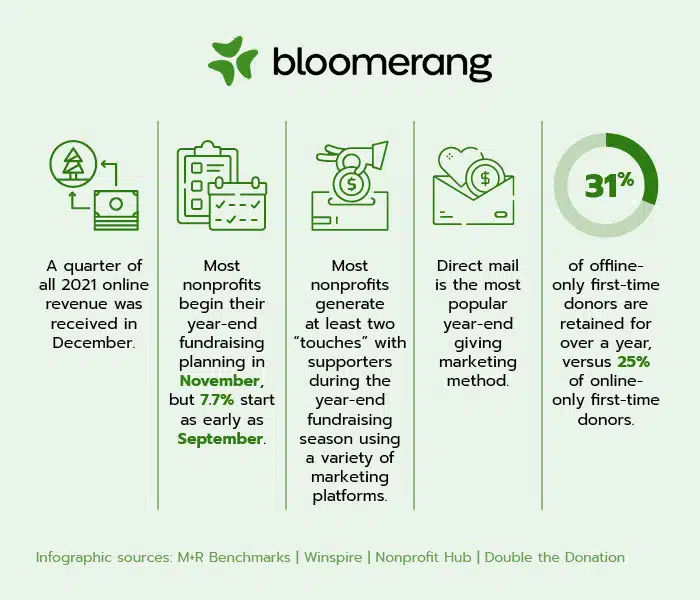The Ultimate Guide To Year-End Giving For Nonprofits


Full Platform Overview Chat With Us



Full Platform Overview Chat With Us




The year-end giving season is your nonprofit’s final push to meet and exceed your financial objectives before the start of next year. This is a popular time for charitable giving because supporters are motivated by the holiday spirit and because it’s the last opportunity for donors in the U.S. to submit tax-deductible gifts.
50% of nonprofits receive the majority of donations from October through December, so it’s critical that you have a plan in place to maximize your fundraising efforts during this time.
In this guide, we’ll review the importance of year-end giving and the best strategies to use to plan a successful campaign. Here’s what to expect:
The sooner you can get started with your year-end campaign planning, the better. This gives your team time to prepare and align on strategy and timelines.
It’s crucial to understand just how important year-end fundraising is for your organization. These statistics illustrate why you should prioritize year-end giving within your overall fundraising strategy:

These statistics illuminate the importance of starting your year-end fundraising planning early and creating impactful written appeals to resonate with your supporters.
You might not have experience creating a formal year-end giving strategy, or you may be looking to update your current strategy. Wherever you’re coming from, here are 10 steps to help you make the most of the year-end giving season and reach your goals.
Planning early allows you to minimize the negative effects of unexpected circumstances and gives your team members enough time to understand their roles and responsibilities.
As a rule of thumb, nonprofits should start preparing and building their year-end giving teams when students return to school for the fall semester, usually three to four months ahead of the campaign period. This ensures that your team doesn’t feel rushed and gives you enough time to prepare a well-rounded, engaging campaign.
To move forward successfully, review your past year-end fundraising performance and determine your strengths, weaknesses, and opportunities for improvement. This will help you strategize for your upcoming campaign and improve year-over-year results.
Assess your previous year-end campaign and ask yourself the following questions:
Determine this year’s goals based on past efforts. For instance, set a fundraising goal that’s slightly higher than in previous years. And, develop a plan to tackle other aspects of your year-end fundraising campaign that didn’t reach their full potential.
If you find that your marketing efforts were misaligned with your audience, conduct more audience research to help understand your supporters better. Or, if you fell short of your fundraising goal last year, brainstorm strategies to improve your marketing and stewardship efforts to connect with current and new donors.
A case for support tells donors why you need their help and what their donations will achieve. It forms the basis of your year-end giving letter.
Build your case for support around individual stories and compelling examples of how your nonprofit is making an impact. This helps put a face to your appeal and generate empathy for your cause.
Follow these steps to tell a complete story:
Your case for support should be accompanied by strong branding (more on this in the next section) and effective design. Also, make sure to follow writing best practices by keeping your paragraphs short and using bolded text strategically to draw attention.
A strong story, partnered with uniform, professional design, leaves a positive impression on recipients. They will see your organization as more credible and trustworthy as a result.
Your year-end giving campaign and marketing efforts should be held together by a unified brand. Ensure all of your marketing materials reflect your organization’s brand by incorporating your logo, fonts, colors, and tone of voice.
You might even create a unique brand for your year-end fundraising campaign, with a memorable theme and slogan. For instance, you might make your campaign holiday-themed or focus your efforts around Giving Tuesday.
In your brand messaging, emphasize that the campaign is a team effort, the donor and your nonprofit are in unison, and your nonprofit relies on the generosity of its supporters to make a real difference in your cause area.
Creating a memorable brand ensures that your year-end fundraising efforts as a whole are memorable and that they stand out in supporters’ social media feeds, email inboxes, and mailboxes.
You can certainly send one year-end email appeal to your entire supporter base. This helps you save time and focus your efforts on other areas of your marketing campaign.
However, many organizations find greater success when they segment their donors. Segmentation involves grouping supporters based on shared characteristics. For instance, you might group supporters based on their engagement level, recency and frequency of giving, or preferred communication channel.
Segmenting your appeals and emails allows you to send the right message to the right audience. Instead of sending one mass email to everyone, you can create tailored year-end giving appeals for each of your major segments. This allows you to send more personalized messages to donors while still saving time and energy.
Ensure each of your messages is also personalized to the recipient by including their names in your email subject lines, addressing messages with donors’ names and titles, and referencing their past donations or other involvement with your organization.
A/B testing is the process of creating two different versions of your year-end appeal and assessing which version receives the most engagement or inspires the most action from recipients.
You can use A/B testing to assess any element of your year-end appeal, from your email subject lines to your body text, images, and calls to action.
As you conduct these tests, make sure to only change one element of your appeal at a time to understand which changes had the biggest impact. By the end of the process, you should be left with a strong fundraising appeal to send supporters in the crucial final weeks or days of the year-end giving process.
People tend to get busy at the end of the year. They might notice your outreach messages, but forget to give or put off giving until later. Also, your supporters, especially those who support multiple causes, will likely receive many year-end appeals from a variety of organizations. An effective communication cadence will help you stand out and maintain their attention.
Also, you’ll be able to ensure your nonprofit’s team members, including your staff members, board members, and other volunteers, understand their roles and when they need to complete certain outreach responsibilities.
Develop a communications calendar for October, November, and December for each segment of your donors with key dates for each touchpoint. Use these steps as a rough guide:
The key to an effective communication cadence is balance. You don’t want to send so many messages that supporters become overwhelmed, but you want to ensure you’re engaging with them to guarantee that everyone who wants to give has a chance to do so.
Supplement your email and direct mail appeals with social media posts and website updates. Share campaign updates, shorter versions of your case for support, and thank-you messages to those who have already donated.
Make it as easy as possible for donors to find your donation page by incorporating a large donate button on your homepage and a variety of call-to-action buttons and links throughout your website pointing visitors to your giving opportunities.
Your online donation form itself should be easy to fill out to facilitate ongoing donations through your website. Design your form with the following strategies to make it user-friendly and convenient:
When your website and online donation form are optimized to support your year-end giving campaign, you can incorporate website links into your other outreach channels, such as your social media posts and emails. Also, you can offer a valuable resource for both existing and new supporters to get to know your organization on a deeper level and understand the full impact of their donations. They can view your online donation page to get all the information they need to make a decision about whether and how much to give.
Expressing appreciation for year-end giving donors helps you turn these supporters into ongoing proponents of your organization. A strong appreciation strategy starts building the groundwork for building stronger relationships with these individuals, giving your nonprofit access to year-round support.
Follow these steps to build an effective appreciation strategy:
Consider hosting an event to wrap up the year-end giving season and thank supporters in person. Events are a great way to reinforce a sense of community within your organization. Year-end giving events can be anything from a gala, grand raffle, auction, seasonal concert, or a play. You can also livestream your event to create a hybrid experience, connecting with both in-person and virtual attendees.
After the year-end giving season ends, assess relevant metrics to determine how well your strategy played out. This lets you know what you should improve or maintain for next year.
Round up metrics such as your:
Compare these numbers to metrics from previous years to identify trends. This information will let you know the areas you should focus on improving for next year’s campaign.
The year-end giving season isn’t just a time to reach out to supporters and gather last-minute donations. It’s also a time to reflect on the progress made throughout the entire year and celebrate your organization’s achievements.
By planning early, creating a strong case for support, and personalizing your donor outreach efforts, you can reach your year-end giving goals and lay the foundation for better supporter relationships next year.
Looking for more information on nonprofit strategic planning and how to improve your fundraising campaigns? Start with these additional resources:
Comments
Kristen Hay
Deborah Miller